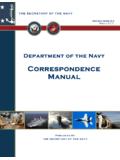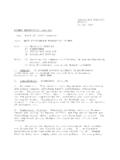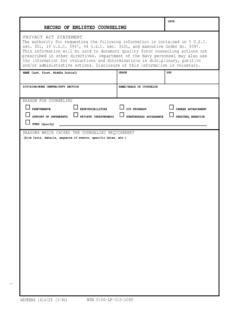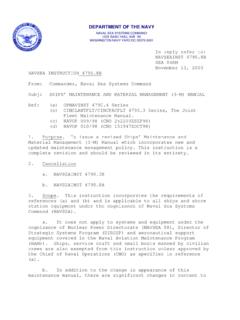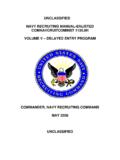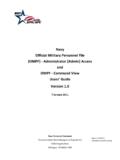Transcription of BUPERSINST 1610.10B PERS-311 - Navy FITREP
1 BUPERSINST PERS-311 . 9 Jul 08. BUPERS INSTRUCTION From: Chief of Naval Personnel Subj: navy PERFORMANCE EVALUATION SYSTEM. Ref: (a) OPNAVINST (b) MILPERSMAN. (c) BUPERSINST (d) SECNAVINST Encl: (1) Overview for Commanding Officers, Delegated Reporting Seniors, and Raters (2) navy Performance Evaluation Manual (EVALMAN). 1. Purpose. To publish revised guidance in performance evaluation and to publish the revised navy Performance Evaluation Manual (EVALMAN). 2. Cancellation. BUPERSINST 3. Information. This revision provides updated administrative and policy changes affecting navy 's performance evaluation system. Enclosure (1) provides an overview of the system for commanding officers (COs), reporting seniors, and raters. The EVALMAN provides requirements for completion and submission of the report forms. Organization of the EVALMAN and a brief summary of the chapters are provided in the Introduction section of enclosure (2).
2 4. Significant Changes. Wherever possible, existing Fitness Report and Counseling Record ( FITREP ) and Evaluation Report and Counseling Record (EVAL) policies have been kept in effect. The most important policy changes contained in this instruction include: a. Introducing a new Chief Petty Officer (E7-E9) evaluation (CHIEFEVAL) NAVPERS 1616/27 (6-08). This evaluation form is not part of the NAVFIT98A application and must be downloaded from the NPC web site at PerformanceEvaluation/SoftwareForms/. Please note that the NAVPERS 1610/2 (3/02), Fitness Report and Counseling (E7-O6). BUPERSINST 9 Jul 08. form in NAVFIT98A will be used for W2 through O6 reports only. A change to the report name will be made at a later date. b. Requiring that the Character trait (Block 37) be used on the new CHIEFEVAL to grade Equal Opportunity performance. For paygrades E7-E9, a trait grade cannot be assigned in Character and maintain a promotion recommendation of Promotable or higher.
3 C. Requiring that the Professionalism trait (Block 35) on the new CHIEFEVAL be used to for Physical Fitness Assessments. The trait grade and performance recommendations shall be graded per reference (a). d. Clarifying reporting responsibilities for members performing Annual Training or Active Duty for Training (AT or ADT) at their gaining commands. The gaining commands have the option to do AT or ADT performance reports for supporting units and individual augmentees. e. Incorporating NAVADMIN 298/07 submission procedures for concurrent reports. 5. Change Recommendations. FITREP , CHIEFEVAL and EVAL. policies, procedures, and requirements may be modified only by change to this instruction. Submit recommendations to navy Personnel Command (NAVPERSCOM) ( PERS-311 ). 6. Forms a. The following forms may be obtained at (1) NAVPERS 1610/2 (3/02), Fitness Report and Counseling Record (E7-O6).
4 Note this form name will be revised at a later date. (2) NAVPERS 1616/26 (3/02), Evaluation Report and Counseling Record (E1-E6). 2. BUPERSINST 9 Jul 08. b. NAVPERS 1610/4 (7-95), Request for Performance Summary Record is available in the BUPERS CD-ROM. c. Following forms are available through the Office of the Chief of Naval Operations, Flag Matters (N00F) at (703) 614-1129/. DSN 224. (1) NAVPERS 1610/5 (5/08), Fitness Report and Counseling Record (O7-O8). (2) NAVPERS 1616/23 MEMORANDUM Signature Authentication, to accept Non CAC user FITREPS. d. NAVPERS 1616/27 (6-08), Evaluation and Counseling Record (E7 E9) is available at 7. Reports. Report Control Symbol BUPERS 1610-1 has been assigned to the reports required by paragraph 3 and is approved per SECNAVINST M. E. FERGUSON III. Vice Admiral, navy Distribution: Electronic only, via BUPERS Web site ructions/.
5 3. BUPERSINST 9 Jul 08. navy PERFORMANCE EVALUATION. SYSTEM. OVERVIEW FOR. COMMANDING OFFICERS, DELEGATED REPORTING SENIORS, AND RATERS. Enclosure (1). BUPERSINST 9 Jul 08. 1. Purpose. This enclosure provides an overview of the navy Performance Evaluation System. While each of the statements in this enclosure constitutes policy, specific actions may require the detailed instructions found in the EVALMAN, enclosure (2). 2. How Does the Report Work? The system utilizes a FITREP for officers (W2-O6), CHIEFEVAL for chief petty officers (CPO). (E7-E9) and an EVAL for other enlisted personnel (E1-E6). Performance traits are graded on a 5-point scale, from (lowest) to (highest), using performance standards printed on the forms. The performance trait grade of represents performance to full navy standards. Higher grades are reserved for performance, which significantly exceeds standards.
6 All grades must be substantiated in the comments, as well as general comments on the remainder of the evaluative blocks. If there is a promotion recommendation of "Significant Problems," or any recommendation against retention, treat the report as adverse. All forms provide a 5-step promotion recommendation scale: "Significant Problems," "Progressing," "Promotable," "Must Promote," and "Early Promote." "Early Promote" recommendations are based solely on performance, and do not require eligibility for early promotion. There are; however, mandatory limits on the number of "Early Promote" recommendations. For paygrades O1. and O2 (with the exception of Limited Duty Officers), no promotion recommendation higher than Promotable is allowed. For the more senior officer and enlisted pay grades, there are also limits on "Must Promote" recommendations.
7 These limits ensure a sufficient range of recommendations to make the reports useful to the promotion system. While there are no corresponding limits on trait grades, they are expected to be consistent with the promotion recommendations. For enlisted personnel, the promotion recommendation is also the performance mark average for the report period. The recommendations are translated into marks of , , , , and , respectively, on the traditional grading scale. 3. Who Can Be a Reporting Senior? a. Commanding officers (COs) and officers in charge (OICs). are a reporting senior by virtue of their command authority. They may submit properly authorized FITREPs, CHIEFEVALs and EVALs on any member who has reported to them for duty, whether junior or senior to them in grade. The term "commanding officer" is inclusive of all services, and their civilian 2 Enclosure (1).
8 BUPERSINST 9 Jul 08. equivalents within the Federal government. An OIC is a reporting senior if they are in charge of commissioned or established activities listed in the Standard navy Distribution List. When a member is assigned to a government activity, the reporting senior is the member's administrative commander unless another reporting senior is assigned by order or directive. A member in this category may receive a letter-type report from the government activity for attachment to a FITREP , CHIEFEVAL or EVAL. b. Delegation of reporting senior authority is an actual transfer of that authority, and not merely an authorization to sign "By direction." For this reason, delegation is held to the highest level consistent with effective observation of performance, and the CO's oversight responsibilities are carefully defined. For specific direction concerning delegated reporting seniors, refer to the EVALMAN, chapter 2.
9 C. An Immediate Superior in Command (ISIC) is a reporting senior for assigned COs and is authorized to assume the reporting senior authority of a subordinate CO whose capacity to act as a reporting senior becomes impaired. Specific guidance is contained in the EVALMAN, chapter 2. d. An enlisted OIC in the grade of E9 and civilians in command positions who hold the grade of GS-9 through GS-12 may sign reports on E5 and below. A CPO or senior chief petty officers (SCPOs) may sign reports on personnel E4 and below only. GS-13 or equivalent may sign reports for E1 to E9. All other reports will be signed by a senior in the chain of command having authority to report on the member concerned. 4. Who are the Raters and Senior Raters? What Do They Do? EVALs on personnel E6 and below require the signatures of a rater and senior rater, as well as the reporting senior.
10 This ensures that navy 's senior enlisted and junior officer supervisors are properly included in the enlisted EVAL process. a. The rater for personnel E1-E4 can be an E6 or civilian equivalent. For personnel E5-E6, the rater should be a navy CPO. whenever possible, but if none is available within the command, the rater may be a military or civilian supervisor who is an E7. equivalent or higher. Typically, the senior rater will be the member's division officer or department head. The senior rater 3 Enclosure (1). BUPERSINST 9 Jul 08. may be omitted where the reporting senior is the rater's immediate supervisor. Exhibit 2-1 in chapter 2 provides guidance on evaluation raters, senior raters, and reporting seniors for various sized commands. b. The development of EVALs must be a team effort. The objective is to develop a better evaluation than could be achieved by any single member of the team.

